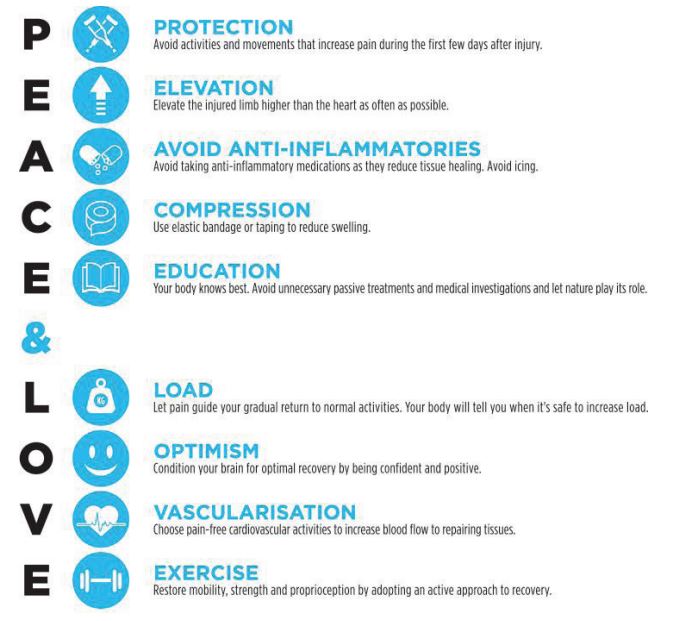Is inflammation from injury always a bad thing?

 Now here’s another topic that polarises [confuses] people… What action should you take when you get injured?
Now here’s another topic that polarises [confuses] people… What action should you take when you get injured?
Before we get into the worst case scenario of dealing with an injury, let me remind you of some basics. As a triathlete, cyclist or runner – whether you’re training ten or twenty hours per week – you MUST have a regimen in place to prevent injury and keep that body ‘on the road’. I can hear you groaning from here! Yes you’ve got it… these are the boring-as-batshit workouts that you all avoid sometime or other: rolling, core exercises, activation, pilates, plyometrics, resistance bands… you know the drill.
Most of you reading this are age group athletes typically juggling training, jobs, pets, families, friends, perhaps study, and [when we’re allowed] socialising, so I understand… being asked to do a 20-minute workout a couple of times per week ON TOP of swim, bike and run workouts is often a step too far. Even though you’d rather listen to Donald Trump discuss Climate Change, these workouts are one of the few things you can do to avoid injury, which – I’m sorry to say – is almost inevitable when you train as often as triathletes do and spend a lot of time teetering between super fit and super fatigued.
Firstly… If you’re naive enough to think that simply swimming, cycling and running a lot will make you a better triathlete you will soon come unstuck either in a race or by injury. I deal with a fair few Type A characters in my role so don’t pretend you’re not one of them! Simply put, what the elites do gradually filters down to World Champs Age Groupers because no-one wants to think on the fact that somewhere out there your next competitor is training in the rain, getting up early, eating clean and yes… getting massages and doing maintenance when you are not. The regular Weekend Warrior may not worry about being pushed off the podium in their next race, but if you fail to line up on the start line because of injury caused by naivety, who’s the loser now?
If you honestly are ‘pushed for time’ I would much rather an athlete sacrifice a swim, bike or run session in favour of some maintenance or a massage. But to be frank, if you can’t find just 20 minutes a couple of times per week – even while you’re catching up on Ru Paul’s Drag Race – I want to hear about it. Your body will thank you for it, you’ll be less sore and once the short strength and stability sessions become second nature your training and race times will drop because your form will massively improve.
RICE POLICE HARM MICE RICER PRICE
Don’t panic, that’s not a headline from the Financial Times, and I didn’t just pass out on the laptop… I’m perfectly lucid. If the above random selection of words doesn’t make much sense to you, then likely neither does your own injury treatment advice if you’ve asked more than one person lately. I’m writing this today because one athlete has recently had a soft tissue injury, and I’ve just renewed my First Aid training for Triathlon Australia – both of which threw up some questions and answers. The soft tissue injury I mention is a good example because in this case it was unavoidable: a strained ankle accident. Don’t for one second assume this isn’t serious because it is.
My own interest in the the topic of injury treatment started long before I was a coach, with an anecdote I discussed at the First Aid session in an effort to glean some answers.
I was half way into a weekend hilly bike ride ten years ago, when I had a serious ITB flare-up and had to pull the pin and phone someone to be picked up when it was too painful to carry on. While I waited for my lift I grabbed a coffee then popped into the nearest pharmacy in the small town I was cycling near. I asked for anti-inflammatory pills and described what the issue was. The chemist handed them over, reminded me to take them with food, but also said “…just don’t take them for the first 48 hours”. Interesting.
Let it also be said that my injury was very avoidable. A few weeks previously I had taken part in a weekend training camp involving some serious ride and run distances on both the Saturday and the Sunday. Prior to riding serious hills on the Saturday – and low on fuel having neglected to gather decent food supplies on the Friday night – I made the very innocuous decision to raise the saddle on my bike just a few millimetres. The fall-out from this quite frankly dumb move didn’t present itself until the 16km run off the bike when I was running like a drunk teenager. The Sunday ride was manageable but I couldn’t run off the bike. Big lessons.
If you’ve been into sports for a while, you’ve very likely heard of the acronym R.I.C.E which stands for Rest Ice Compression and Elevation. This has long been the staple advice for soft tissue injuries occurring in sport or otherwise, and – as attested to in my first aid course – still taught in the text books… albeit amended to RICER… the latter ‘R’ standing for “Referral: Refer the casualty to professional medical advice for assessment of extent soft tissue damage“.
The various phases of inflammation help repair damaged soft tissues. Thus, inhibiting inflammation using medications may negatively affect long-term tissue healing, especially when higher dosages are used.
Vuurberg G, Hoorntje A, Wink LM, et al. Diagnosis, treatment and prevention of ankle sprains: update of an evidence-based clinical guideline. Br J Sports Med 2018;52:956
Well now isn’t this a quandry… rest, ice and compression are all recommended for the purpose of reducing internal bleeding, lowering pain and REDUCING SWELLING. Why then, would the pharmacist miles from my home advise against taking anti-inflams – the very things I thought would also help reduce the pain and swelling?
The nub of the issue of course is that the medical profession are constantly improving and changing their advice due to statistics, feedback and that old chestnut science. For example, we now carry out CPR to the same compression:breaths ratio for all people regardless of age, as opposed to the old thinking that infants, children and adults should be treated differently. Statistically, people attempting first aid were so flummoxed trying to remember which ratio to use that they effectively froze, wasting valuable seconds in the fight for survival. Because it is also decreed “doing something is better than doing nothing” in an emergency it was decided that CPR was CPR. Period.
Science – Noun – (knowledge from) the careful study of the structure and behaviour of the physical world, especially by watching, measuring, and doing experiments, and the development of theories to describe the results of these activities.
Cambridge English Dictionary
Imagine then that the same studies on the human body are continually happening in the field of sports science and things like stretching (for another day!), warming-up (ditto!) and the treatment of injuries is also evolving over time. It just so happens that the pharmacist all those years ago was way ahead of his time. This means that articles and papers are written, a handful of which I have read…
The high level articles that I read focused on how to put into practice the particular Mnemonic they were endorsing and for how long, whereas the more detailed papers delved deeper into testing the evidence for recent treatment strategies. It should be said that only two of the articles I read mentioned NSAIDs (non steroidal anti-inflammatory drugs) so there was no commentary on whether they were endorsed or not. The focus of most experiments and studies seems to be whether icing an injured body part helps or hinders the healing, explained by the fact that most acronyms we’ve heard all include “I”.
While there is no direct evidence that ice is harmful to the healing process, its use as a recovery tool is questionable, particularly after intensive eccentric exercise (such as pitching). This may be because the recovery process is different from the healing process. It is unwise to equate recovery to healing from a physiological perspective until scientists can identify specific mechanisms associated with recovery such as delayed onset muscle soreness (DOMS).
Phil Page, PhD – Cramer Sports Medicine, June 1st 2018
Now here’s the crux of the matter… recent studies appear to have addressed the fact that – although healing is obviously key – just as important are the recovery and getting back into your sport. In fact, healing and recovery are very different phases for the human body. Ice has long been recommended for post workout recovery but the evidence is certainly mixed, with strong leaning towards ice being good for pain management for the first 2-3 days following a soft tissue injury and perhaps reducing damage to surrounding tissue but not much else.
Hence we hear about RICE evolving into PRICE with “P” standing for ‘Protection’: “Injured tissues must be protected against further injury. Protect your small injuries by applying bandages, elastic wraps, or simple splints. Something as easy as taping an injured toe to its healthy neighbor can do the job. See your doctor for problems that require precision splints or casts”.
Further on, not only do healing and recovery appear to be divided, but as mentioned above the prospect of ‘what’s next and how do I get back to training?‘. With that in mind, POLICE also uses ‘Protection’ but considers Optimal Loading while you know the rest. It then becomes apparent that some movement can actually stimulate healing.
That recovery after injury is improved with movement, not rest, was published in that banner year, 1996, by Dr. Jim and Phil Wharton in The Wharton’s Stretch Book. They suggested the acronym MICE to replace RICE, where Rest is replaced with Movement. The Whartons advocated that once fracture or catastrophic injury is excluded: movement is best, not rest, to treat an injury. They encourage immediate but gentle restoration of active range of motion with gradual introduction of functional activities. They note that inactivity shuts the muscle down. Blood flow is restricted and tissue atrophy follows. In contrast, activity improves blood flow, which brings oxygen and removes metabolic waste.
Dr Jennifer Robinson – The University Of British Columbia, October 18th, 2017
If nothing else, we’ve just removed the excuse for laying on the couch for days if you’ve been injured… you can see from Jennifer’s research that it’s likely to postpone improvement and perhaps cause temporary damage. Don’t get carried away though, this movement needs to be controlled and make sense, you can’t just go straight back out and finish that run.
Jennifer goes on to highlight the findings that ice application does not help, telling us that the resulting vasoconstriction from cooling, not only reduces tissue oxygenation with necrosis if extreme, but inhibits the inflammatory response needed to initiate healing. In addition, she explains that Professor James McCormack confirms there is no evidence non-steroidal anti-inflammatories (NSAID) improve the outcome of acute sports injuries or reduce swelling. Well would you look at that. One paper actually says the prolonged use of NSAIDs can cause renal, gastrointestinal and heart issues.
My favourite part of Jennifer’s article was recounting an example of a hockey star who returned to playing quite rapidly after ACL surgey. The fellow – although obviously well conditioned – stated that his mental strength was what got him through. She says “I believe the emotional cost of injury may be moderated by permission to move immediately. It starts with range of motion and walking. Cross training can maintain fitness and supplement strengthening drills. Low intensity practices start soon, with a gradual progression to full participation when sufficient strength and agility is realised.” She describes this as the ‘Emotional Cost of Injury’ and I love the approach that mental wellness is acknowledged as a factor in the body’s readiness to train (I have a blog post coming out soon on this very topic).
Jennifer states that her own practice has steered away from MICE and instead recommends:
Movement, not rest.
Options: offer other options for cross training.
Vary rehabilitation with strength, balance and agility drills.
Ease back to activity early for emotional strength.
Swelling isn’t good for us all the time. It initially helps by recruiting healing factors that accelerate how quickly cells migrate to the site of injury – but swelling is also bad because it destructs and distends the tissues, and distorts the anatomy. Fluid enzymes within the swollen fluid break-down tissue as well as stimulating it.
Actually immediate swelling is required for tissue repair. Immediate swelling releases enzymes that break down tissue, along with anabolic factors and cells that re-build tissue. Late swelling is almost always harmful, as those same enzymes have already done their job and now attack healthy tissue.
Kevin R. Stone, MD – Orthopaedic Surgery, Sports Medicine & Rehabilitation, October 14th 2015
So Kevin basically explains why the first 2-3 days are crucial, with swelling later on not doing us any good… “just don’t take them for the first 48 hours”.
Before I actually leave you alone to get back to Ru Paul, the penultimate Mnemonic not yet mentioned is HARM… as in DO NO HARM. This acronym goes beyond the somewhat obvious precautions we take to highlight some mistakes athletes are making:
No Heat – heat will increase bleeding.
No Alcohol – alcohol increases bleeding and swelling (heartbreaking for some)
No Running – running or exercise increases blood flow, delaying healing.
No Massage – massage increases swelling and bleeding, also delaying healing.
As you can see, it’s a minefield of information and after lots of reading I thought I’d contact my own physio (Thanks Hannah!) – a graduate not too long ago – to ask what the current teaching is. Within minutes, she shared with me a study from the The British Journal of Sports Medicine which was written this year. As you’ll see below… this really does sum up all of the good bits on how to treat an injury. If you would like the full text drop me a line and I’ll send it to you.

Peace.
W.
